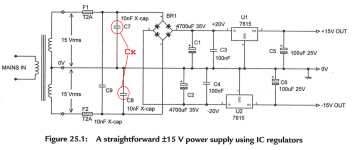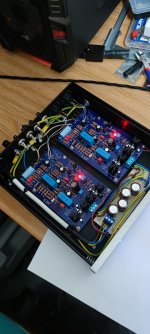You could for a start try reading the entire thread.The kits are available again. Ordered a couple and now I hope for suggestions based on all your collective and individual experiences and findings on how to build the 'ultimate' Pearl.
I know for a fact, that some in here are pretty tired of repeating themselves 😉
No pun intended, but if you do a little diggin´. all the answers are here.
Standard wisdom: build the standard design to start, then mod away after you prove it's working as designed.
While you're reading 282 pages - some hot topics to look for include:
Op amp rolling
SMD vs through hole JFETs
Resistor R27 to set current
Which power supply? Standard? UDP3? Dual mono? Pre-regulated? SMPS with filter? Other options?
Fine tuning gain / loading resistors for your cartridge(s)
While you're reading 282 pages - some hot topics to look for include:
Op amp rolling
SMD vs through hole JFETs
Resistor R27 to set current
Which power supply? Standard? UDP3? Dual mono? Pre-regulated? SMPS with filter? Other options?
Fine tuning gain / loading resistors for your cartridge(s)
Thanks for your help rhthatcher! I allready have one Pearl3, with standard parts and power supply. And I enjoy it a lot. But I was in time now to order 2 kits, I know I know greedy greedy. With those I will try to improve on that standard solution using the experience , know how and ideas from this great community. I am going through the whole thread and am learning all the time😎. After reading and following your tips their will be more specific questions I think.
Tom saw oscillation ~877 kHz in this article: https://neurochrome.com/pages/rectification-snubbers .2 horizontal divisions per period, at 5 usec per division, equals 10 usec per period. Frequency = 1/1E-5 = 1E+5 = 100 kHz. Nothing for an AM radio to receive. I am surprised it didn't occur to you to make a quick check whether the wiggles were, or were not, within the AM band.
Yep, with Cx = 0 ("No Snubber" at the top of his scope trace) TomC measured 877 kHz. And with Cx != 0, I measured 100 kHz. The ringing frequency will vary with transformer type, rectifier type, and presence or absence of Cx.
Lots of equipment includes Cx without Rs (Figures 6-8 of the QM design note show three examples) and that will lower the ringing frequency, often below the bottom of the AM band (565 kHz). To name an influential example, Douglas Self continues to recommend Cx without Rs for preamps, line stages etc, even in the Second Edition of his book Small Signal Audio Design.
Self's Figure 25.1 from page 709, is attached below. DougS's 10nF, when placed in parallel with TomC's 1.9nF of trafo+rectifier capacitance, lowers the ringing frequency by a factor of sqrt(11.9 / 1.9) = 2.5X , i.e. from 877 kHz to 350 kHz. Out of the AM broadcast band. The different physical size and VA ratings of the transformers used (one's a power amp, the other's a preamp) will affect the results as well.
_
Lots of equipment includes Cx without Rs (Figures 6-8 of the QM design note show three examples) and that will lower the ringing frequency, often below the bottom of the AM band (565 kHz). To name an influential example, Douglas Self continues to recommend Cx without Rs for preamps, line stages etc, even in the Second Edition of his book Small Signal Audio Design.
Self's Figure 25.1 from page 709, is attached below. DougS's 10nF, when placed in parallel with TomC's 1.9nF of trafo+rectifier capacitance, lowers the ringing frequency by a factor of sqrt(11.9 / 1.9) = 2.5X , i.e. from 877 kHz to 350 kHz. Out of the AM broadcast band. The different physical size and VA ratings of the transformers used (one's a power amp, the other's a preamp) will affect the results as well.
_
Attachments
Last edited:
Greetings,
Can a passive pre be used after the pearl 3?
Or a simple volume control
Thanks
Erica
Can a passive pre be used after the pearl 3?
Or a simple volume control
Thanks
Erica
Thanks to 6L6's patience, eyes, skill and kindness my Pearl 3 is fully operational. After all the troubles, self-owns, and frustrations, the sleuthing and generosity of the crew here was critical to success...turned out to be two tiny solder bridges that i would have never been able to see any more.
Profound thanks to all who pitched in to help. It's going to be a fun week getting to know the sound!
Profound thanks to all who pitched in to help. It's going to be a fun week getting to know the sound!
As always - 6L6 is a true gentleman. Enjoy the music Spoiler!
I've now received the boards and putting things in place to begin the build. I realise the recommendaiton is for a separate PSU using the board provided, but I have a Rotel phono case which has a 17vdc supply already in situ (see image). This looks like a basic transformer/bridge rectifier/caps/regulators. I'm considering scrapping the rest of the board (which isn't functioning) and locating the 2 x pearl board within the chassis. The transformer looks like it's surrounded by steel panels and I am considering putting in place additional panels between the transformer and the board to isolate the tranny. Any thoughs on this and what kind of panel would be most effective in isolating the transformer from the boards?

Mild steel works well when you're trying to attenuate the 50 Hz magnetic fields which transformers radiate. I'd recommend making a solid mechanical connection and also a solid electrical connection to chassis earth. Mild steel is a ferromagnetic material, while aluminum and copper are not.
I'd recommend making a solid mechanical connection and also a solid electrical connection to chassis earth.
Do you mean both? If the panel is bolted to the chassis and the chassis earthed to mains then does it also need an additional electrical connection to earth?
Do you mean both? If the panel is bolted to the chassis and the chassis earthed to mains then does it also need an additional electrical connection to earth?
the Pearl transformer won't be the only -- or most powerful -- transformer in a system. the closest (perhaps).
if you're going to add shielding perhaps enclosing the signal boards with a mild steel box is a better approach?
if you're going to add shielding perhaps enclosing the signal boards with a mild steel box is a better approach?
Hi,
a new Pearl 3 is born, I'm happy 😍




a new Pearl 3 is born, I'm happy 😍
- Home
- Amplifiers
- Pass Labs
- Pearl 3 Burning Amp 2023

